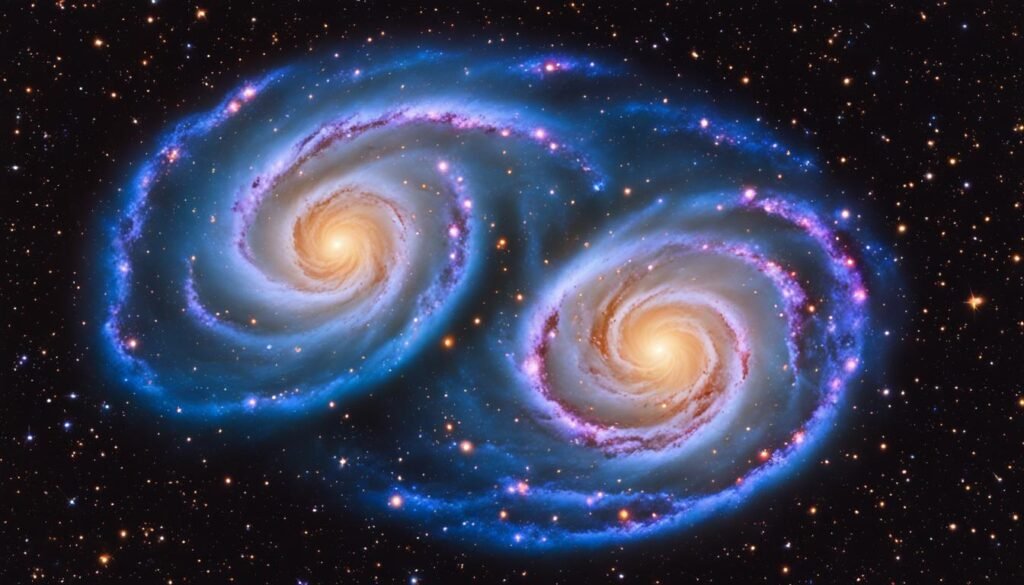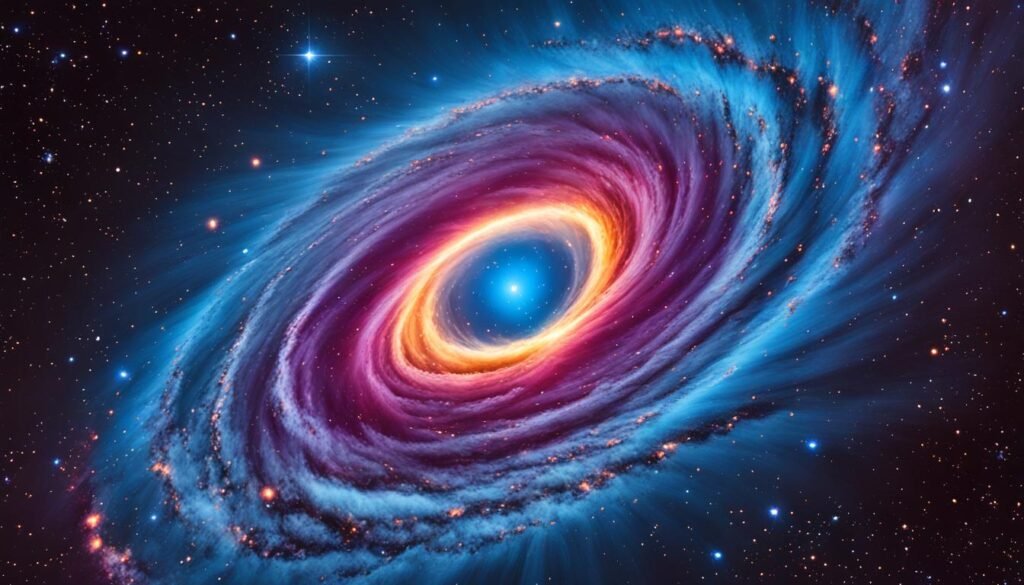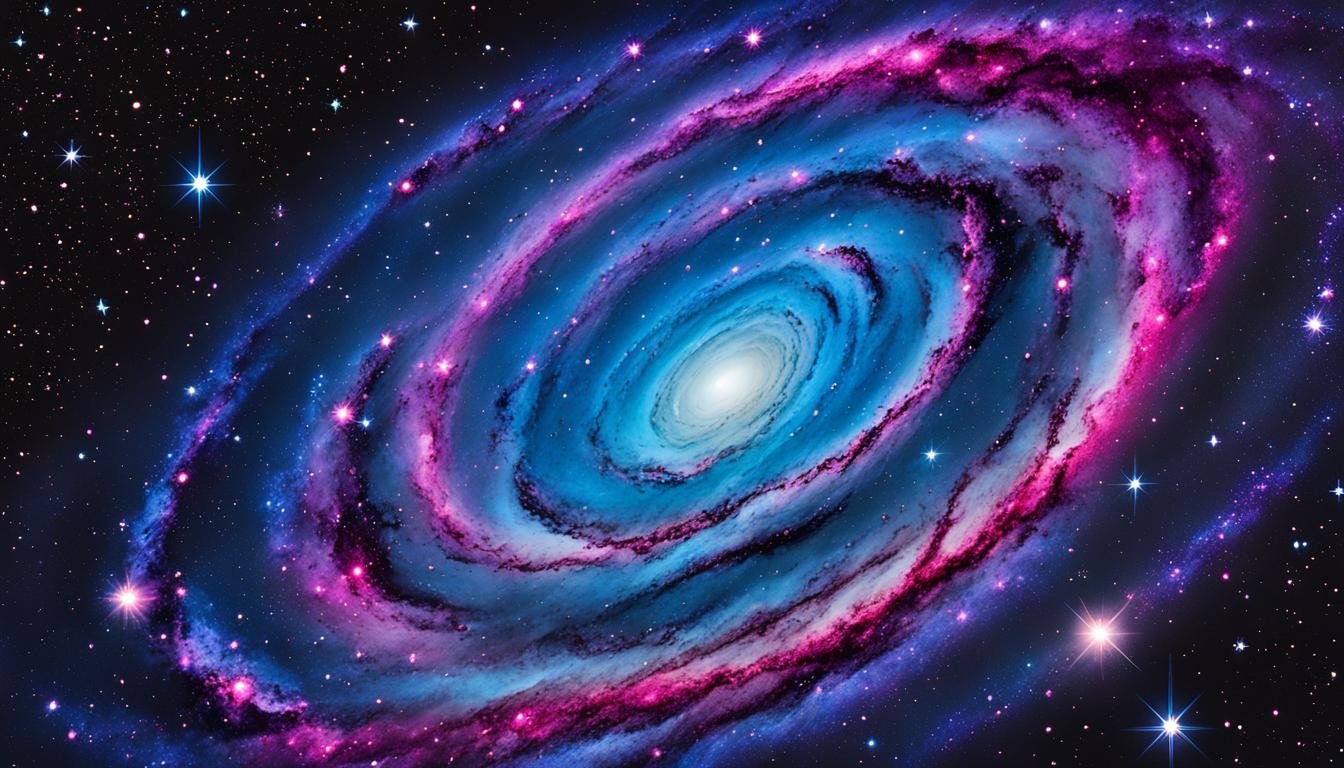If you’re a fan of astronomy, then you’ve probably heard of Messier 49 (M49) – a stunning elliptical galaxy that resides in the Virgo constellation. This magnificent celestial object, also known as NGC 4472, is a captivating sight in the night sky.
Discovered by Charles Messier in 1771, Messier 49 is located approximately 56 million light-years away from Earth. With its impressive diameter of 157,000 light-years, it showcases the grandeur of the cosmos. As the brightest member of the Virgo Cluster, M49 holds a prominent place in the universe.
Key Takeaways:
- Messier 49 (M49) is an elliptical galaxy located in the Virgo constellation.
- Discovered by Charles Messier in 1771, it is approximately 56 million light-years away from Earth.
- Messier 49 spans a diameter of 157,000 light-years, making it a sight to behold.
- As the most luminous member of the Virgo Cluster, M49 shines brightly in the night sky.
- This massive galaxy harbors a supermassive black hole with a mass of around 565 million solar masses.
Features of Messier 49
Messier 49, classified as an E2-type elliptical galaxy, exhibits a smooth and featureless appearance, distinguishing it from spiral galaxies. Composed primarily of older, redder stars, Messier 49 does not display any indications of recent star formation. This majestic galaxy is home to an estimated 200 billion stars, contributing to its immense size and gravitational pull. In addition, Messier 49 boasts a remarkable richness in globular clusters, with approximately 5,900 detected clusters.
These globular clusters within Messier 49 possess an average age of 10 billion years, providing valuable insight into the galaxy’s history and stellar evolution. The nucleus of Messier 49 acts as an X-ray source, suggesting the presence of a supermassive black hole with a mass of approximately 565 million times that of our sun.
Statistics of Messier 49:
| Category | Details |
|---|---|
| Galaxy Type | E2-type elliptical galaxy |
| Stars | Approximately 200 billion |
| Globular Clusters | Approximately 5,900 |
| Globular Cluster Average Age | 10 billion years |
| Supermassive Black Hole Mass | Approximately 565 million solar masses |
Messier 49 in the Virgo Cluster
Messier 49, also known as M49 or NGC 4472, is the first member of the Virgo Cluster of galaxies to be discovered. This giant elliptical galaxy is located approximately 54 million light-years away from Earth and spans a diameter of about 157,000 light-years.
The Virgo Cluster itself is a large cluster of galaxies, and Messier 49 is gravitationally interacting with the nearby dwarf irregular galaxy UGC 7636. This interaction between galaxies provides astronomers with valuable insights into the dynamics and evolution of galactic systems.
Messier 49 can be found in the Virgo B subcluster, which is located about 4.5 degrees away from the dynamic center of the Virgo Cluster. It is positioned about 5 degrees south of the Virgo Cluster’s center.
To get a visual representation of the relationship between Messier 49 and the Virgo Cluster, refer to the following table:
| Galaxy/Cluster | Distance from Earth (million light-years) | Diameter (light-years) |
|---|---|---|
| Messier 49 | 54 | 157,000 |
| Virgo Cluster | N/A | Approximately 157,000 |
| Virgo B Subcluster | N/A | N/A |
Note: The exact distances and diameters of the Virgo Cluster and Virgo B Subcluster may vary slightly, as they are estimates based on current observations.
This table provides a glimpse into the scale and proximity of Messier 49 within the larger context of the Virgo Cluster. It highlights the immense size of the cluster and the significant distance between the subcluster and the dynamic center.

Now that you have a better understanding of Messier 49’s position in the Virgo Cluster, let’s explore the supernova events and interactions associated with this fascinating elliptical galaxy in the upcoming sections.
Supernova and Interactions
Only one supernova event has been detected in Messier 49. The supernova, designated SN 1969Q, was discovered in June 1969 and reached a magnitude of 13.0. This rare occurrence provided astronomers with valuable insights into the dynamic nature of galaxies.
Messier 49 also exhibits fascinating interactions with the nearby dwarf irregular galaxy UGC 7636. The gravitational interaction between these two galaxies has led to the formation of a distinctive trail of debris. Spanning approximately 6 by 30 kiloparsecs, this trail serves as a visual testament to the powerful forces at play within the cosmic realm.

The Supernova Event – SN 1969Q
The discovery of SN 1969Q in Messier 49 not only captured the attention of astronomers but also highlighted the extraordinary nature of this elliptical galaxy. Supernovae are extremely energetic events that occur when massive stars reach the end of their stellar evolution and undergo a cataclysmic explosion. These events release an enormous amount of energy, briefly outshining entire galaxies.
By studying supernovae such as SN 1969Q, scientists can gather invaluable information about the life cycles of stars, the creation of heavy elements, and the impact these explosive phenomena have on surrounding galaxies and the cosmic structure as a whole.
Interactions with UGC 7636
The interactions between Messier 49 and the nearby UGC 7636 have added another layer of complexity to the understanding of galaxy evolution and dynamics. The gravitational forces between these two galaxies have induced tidal effects, distorting their shapes and triggering various observational phenomena.
Through meticulous analysis of the debris trail created by these interactions, astronomers have gained insights into the mechanisms of galaxy mergers, the redistribution of gas and dust, and the formation of new stars. These observations contribute to our understanding of how galaxies evolve and ultimately shape the vast cosmic tapestry we observe today.
Discovery and Observations of Messier 49
Messier 49, initially cataloged as a faint nebula, was discovered by Charles Messier on February 19, 1771. Through meticulous observations, Messier 49 has revealed itself to be a fascinating giant elliptical galaxy in the Virgo constellation. When observed with large binoculars, it appears as a hazy patch of light. However, with 4-inch telescopes, its bright core becomes visible, showcasing its grandeur. By employing larger instruments, astronomers are able to witness the full extent of Messier 49’s large halo.
The significance of observing Messier 49 cannot be overstated. It has provided valuable insights into the nature of elliptical galaxies and expanded our understanding of their properties. These observations have revealed the presence of supermassive black holes and shed light on the age and characteristics of globular clusters within Messier 49. Such discoveries have not only enriched our knowledge of this unique galaxy but have also enhanced our overall comprehension of the universe.
Messier 49’s discovery and ongoing observations have paved the way for further exploration and research in the field of astronomy. By unlocking the mysteries of this stellar entity, scientists can continue to deepen our understanding of celestial phenomena and unravel the secrets of the cosmos.
FAQ
What is Messier 49?
Messier 49 (M49) is a giant elliptical galaxy located in the Virgo constellation. It is also known as NGC 4472.
How far is Messier 49 from Earth?
Messier 49 is located approximately 56 million light-years away from Earth.
What is the size of Messier 49?
Messier 49 spans a diameter of 157,000 light-years.
What type of galaxy is Messier 49?
Messier 49 is classified as an E2-type elliptical galaxy.
How many stars are in Messier 49?
Messier 49 contains an estimated 200 billion stars.
Are there any supernovae in Messier 49?
Only one supernova event, SN 1969Q, has been detected in Messier 49.
Is Messier 49 interacting with any other galaxies?
Messier 49 is gravitationally interacting with the nearby dwarf irregular galaxy UGC 7636.
When was Messier 49 discovered?
Messier 49 was discovered by Charles Messier on February 19, 1771.
What can be seen in observations of Messier 49?
Messier 49 appears as a hazy patch of light in large binoculars and reveals its bright core with 4-inch telescopes.






